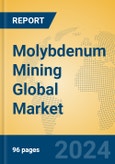Molybdenum mining is a vital segment of the metals industry, supporting alloys, chemicals, and energy infrastructure, with global reserves estimated at 15,000 kilotons and 2024 production at 260,000 tons. Occurring in porphyry deposits as a primary sulfide or copper byproduct, molybdenum’s supply is dominated by China, Peru, Chile, the U.S., and Mexico, which collectively account for 90% of output, with China contributing about 40%. Resources are sufficient for future needs, though declining ore grades at copper mines - expected to close by the mid-2030s - pose supply risks.
In 2024, a Canadian firm announced plans to restart its Idaho molybdenum mine by 2027, signaling efforts to bolster Western supply. China’s February 4, 2025, export controls on molybdenum and other rare metals reflect strategic resource management amid clean energy demand, particularly in power generation and infrastructure. The U.S. holds 5.4 million tons of reserves, with growing interest in domestic production to support climate goals.
This product will be delivered within 1-3 business days.
In 2024, a Canadian firm announced plans to restart its Idaho molybdenum mine by 2027, signaling efforts to bolster Western supply. China’s February 4, 2025, export controls on molybdenum and other rare metals reflect strategic resource management amid clean energy demand, particularly in power generation and infrastructure. The U.S. holds 5.4 million tons of reserves, with growing interest in domestic production to support climate goals.
Market Size and Growth Forecast
The global molybdenum mining market is projected to reach USD 6 billion to USD 8 billion by 2025, with an estimated CAGR of 3% to 5% through 2030, driven by industrial and energy sector growth.Regional Analysis
Asia Pacific expects growth of 3.5% to 5.5%, with China leading production and consumption, though export curbs may shift dynamics. South America anticipates 2.5% to 4%, with Peru and Chile sustaining copper byproduct output. North America projects 3% to 4.5%, with the U.S. and Canada ramping up for energy needs. Europe expects 2% to 3.5%, relying on imports for steel and chemical industries.Application Analysis
- Molybdenum Alloy: Projected at 3% to 5%, dominates due to steel and energy applications, with trends toward high-strength alloys.
- Molybdenum Metal: Expected at 2.5% to 4%, used in electronics, with steady growth.
- Molybdenum Chemicals: Anticipated at 2% to 3.5%, serves catalysts and pigments, with clean energy boosting demand.
Key Market Players
- Jinduicheng Molybdenum: A Chinese leader, Jinduicheng is a top primary molybdenum producer.
- CMOC Group: A Chinese giant, CMOC integrates molybdenum with other metals.
- Yichun Luming Mining: A Chinese firm, Yichun focuses on molybdenum extraction.
- Luoyang Nonferrous: A Chinese company, Luoyang supplies molybdenum regionally.
- China Gold: A Chinese state-owned entity, China Gold mines molybdenum alongside gold.
- Huaxia Jianlong: A Chinese player, Huaxia targets molybdenum for industrial use.
- Freeport-McMoRan: A U.S. firm, Freeport extracts molybdenum from copper mines.
- Codelco: A Chilean company, Codelco produces molybdenum as a copper byproduct.
- Southern Copper Corp: A Peruvian-U.S. firm, Southern mines molybdenum in the Americas.
- Rio Tinto: A UK-Australian giant, Rio Tinto includes molybdenum in its portfolio.
- Antofagasta: A Chilean firm, Antofagasta focuses on copper-molybdenum output.
- KGHM: A Polish company, KGHM mines molybdenum as a copper byproduct.
Porter’s Five Forces Analysis
- Threat of New Entrants: Moderate. Capital needs are high, but byproduct nature lowers barriers.
- Threat of Substitutes: Moderate. Alternatives like vanadium compete in alloys.
- Bargaining Power of Buyers: Moderate. Steel and energy firms have leverage, balanced by supply concentration.
- Bargaining Power of Suppliers: High. Few producers, led by China, hold sway.
- Competitive Rivalry: Moderate. Global players compete on scale and cost.
Market Opportunities and Challenges
Opportunities
- Clean Energy: Power generation and infrastructure drive demand.
- Western Supply: U.S. and Canada restarts bolster diversification.
- Stable Reserves: Adequate resources ensure long-term supply.
- Industrial Growth: Steel and chemical uses expand.
- Tech Advances: Improved recovery enhances output.
Challenges
- Export Controls: China’s restrictions disrupt supply.
- Declining Grades: Copper mine closures threaten byproduct supply.
- Geopolitical Risks: Trade tensions affect access.
- Environmental Costs: Mining impacts face scrutiny.
- Demand Variability: Economic cycles influence consumption.
This product will be delivered within 1-3 business days.
Table of Contents
Chapter 1 Executive SummaryChapter 2 Abbreviation and Acronyms
Chapter 3 Preface
Chapter 4 Market Landscape
Chapter 5 Market Trend Analysis
Chapter 6 Industry Chain Analysis
Chapter 7 Latest Market Dynamics
Chapter 8 Trading Analysis
Chapter 9 Historical and Forecast Molybdenum Mining Market in North America (2020-2030)
Chapter 10 Historical and Forecast Molybdenum Mining Market in South America (2020-2030)
Chapter 11 Historical and Forecast Molybdenum Mining Market in Asia & Pacific (2020-2030)
Chapter 12 Historical and Forecast Molybdenum Mining Market in Europe (2020-2030)
Chapter 13 Historical and Forecast Molybdenum Mining Market in MEA (2020-2030)
Chapter 14 Summary For Global Molybdenum Mining Market (2020-2025)
Chapter 15 Global Molybdenum Mining Market Forecast (2025-2030)
Chapter 16 Analysis of Global Key Vendors
List of Tables and Figures
Companies Mentioned
- Jinduicheng Molybdenum
- CMOC Group
- Yichun Luming Mining
- Luoyang Nonferrous
- China Gold
- Huaxia Jianlong
- Freeport-McMoRan
- Codelco
- Southern Copper Corp
- Rio Tinto
- Antofagasta
- KGHM








